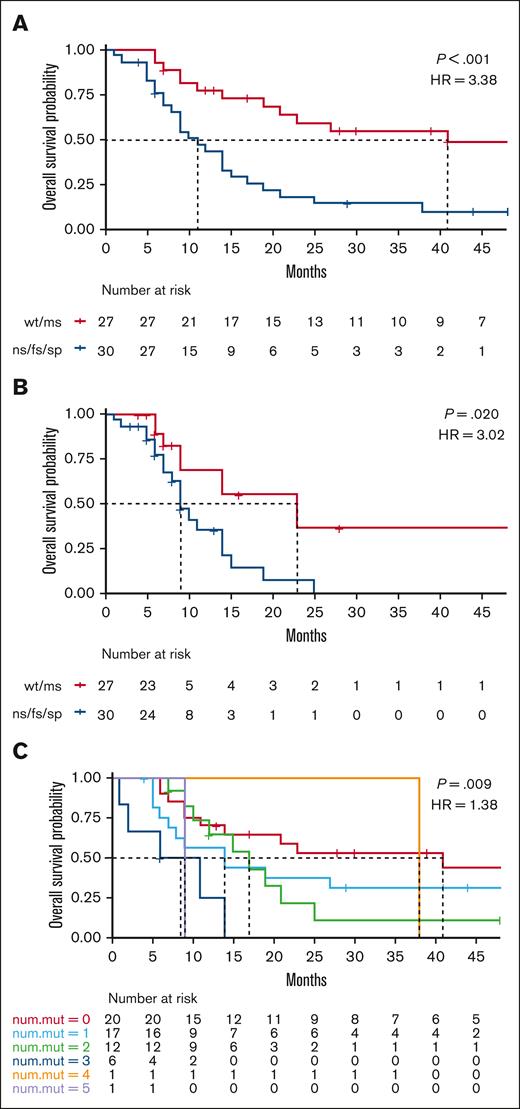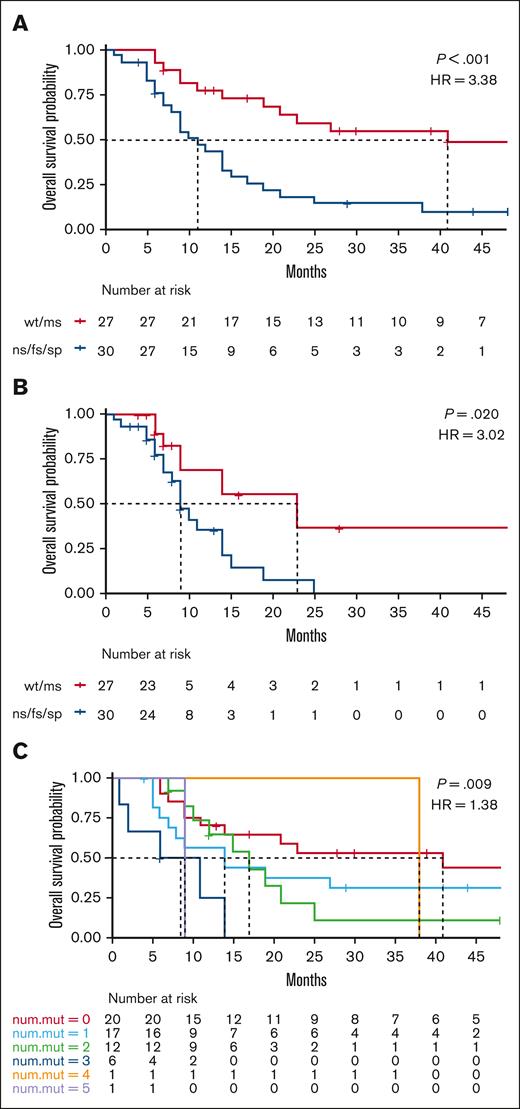TO THE EDITOR:
Blastic plasmacytoid dendritic cell neoplasm (BPDCN) is a rare malignancy with highly varied clinical presentation and patterns of progression.1,2 The multiple sites involved include the skin, bone marrow, lymph nodes, and peripheral blood2 as well as the central nervous system.3 Diagnosis is most frequent in older males.4,5 The overall survival is affected with an increase in age,4,6 presence of more than 3 cancer gene mutations,6 and presence of DNA methylation gene mutations.6 Comparisons for each DNA methylation gene showed no such correlation.6 The most recurrently mutated gene related to DNA methylation is TET2,7 a gene also frequently mutated in clonal hematopoiesis.8 Many patients with BPDCN harbor 2 mutations, some individuals having multiple, up to 8, mutations that are likely in multiple subclones.6,9-13 These mutations demonstrate that there is substantial heterogeneity within the disease.14 Patients with BPDCN and those with cerebral spinal fluid found in lumbar punctures are more likely to have TET2 mutations, complex genetics, and bone marrow involvement than those without these features.3 These mutations occur as frameshift, stopgains, or missense point mutations throughout the TET2 gene, many of which are predicted to be deleterious. Truncating mutations (stopgain, frameshift, or splice) in TET2 are more likely to be deleterious than missense mutations, with an adverse impact on lifespan in a genome-wide association study of over 200 000 UK Biobank participants.15 They can lead to nonsense-mediated decay, loss of important catalytic domains, a translated product that is too short for proper folding to occur, and gain-of-function, as seen for truncating mutations in PPM1D.16 We hypothesized that having at least 1 TET2 truncating mutation in a given patient with BPDCN would lead to worse overall survival as compared with wild-type or missense mutations. To test this hypothesis, we reviewed a cohort of 57 patients, 50 of whom were recently diagnosed with BPDCN via next-generation sequencing, performed using either a 28- or 81-gene panel that interrogates the most frequently mutated genes in myeloid neoplasms as part of the clinical workup. Of these, 26 patients (46%) underwent stem cell transplant: 7 with wild-type or missense TET2 and 19 with truncating TET2. Ten patients had concurrent diagnoses of other hematologic neoplasms, including myelodysplastic syndrome (n = 5), chronic myelomonocytic leukemia (n = 3), primary myelofibrosis (n = 1), and polycythemia vera (n = 1). In 5 patients, concurrent myeloid neoplasms and BPDCN occurred in the same bone marrow. Seven out of 10 patients died: the causes of death included BPDCN in 5 patients, acute myeloid leukemia that evolved from chronic myelomonocytic leukemia in 1 patient, and graft-versus-host disease in 1 patient. Permission to collect samples during the trial was obtained by informed consent administered by the MD Anderson Cancer Center institution review board.
When mapping the TET2 mutations (those with variant minor allele frequencies < 0.01 in all populations examined in the gnomAD database), they occurred throughout the TET2 gene with a clustering of missense mutations within the N-terminal portion of the dioxygenase domain (supplemental Figure 1). Many of these TET2 mutations had allele frequencies, suggesting that they were either germ line or derived from clonal hematopoiesis (supplemental Table 1). Germline DNA was not available to confirm either of these hypotheses. Next, we separated the patients into 2 groups based on their TET2 mutation status (excluding common polymorphisms with minor allele frequencies > 0.01). The first group included patients with either no TET2 alterations (wild-type) or only missense changes. The other group included those with at least 1 truncating mutation in TET2 (nonsense, frameshift, and splice site) (supplemental Table 1). Truncating mutations can cooccur with or without missense or truncating mutations. We found that overall survival was significantly worse in patients with at least 1 truncating mutation in the bone marrow (hazard ratio [HR] = 3.38; P < .001) (Figure 1A) than in those with either no mutations or just missense mutations. This finding was still significant (HR = 3.02; P = .020) when the survival data were censored at the time of the stem cell transplant (Figure 1B). Regarding the number of TET2 mutations per patient, patients with more than 1 mutation had worse overall survival than those with only 1 mutation (Figure 1C) (HR = 1.38; P = .009). This significance was not observed when the analysis was repeated using only truncating mutations, suggesting that having at least 1 truncating mutation had the same effect as having multiple truncating TET2 mutations. In addition, the significance of this finding (P = .01) was ∼100-fold lower than that of the truncating mutation (Figure 1A; P = .0002). In univariate analysis, TET2 truncating mutations (HR = 4.653; P = .0006) and age at diagnosis (HR = 1.052; P = .001) were the 2 factors that were significantly associated with overall survival. In multivariate analysis, having at least 1 TET2 truncating mutation was the only risk factor significantly associated with overall survival (HR = 3.452; P = .032) (Table 1). It has been reported that patients with acute myeloid leukemia and TET2 mutations have significantly higher white blood cell counts, peripheral blasts, serum lactate dehydrogenase levels, and lower platelets.17 However, we did not observe this association in our cohort of patients with BPDCN.
TET2 truncating mutation is associated with poor overall survival. Kaplan-Meier curves depicting 57 patients, including 5 patients with BPDCN and other myeloid neoplasms in the same bone marrow. (A) Overall survival of the cohort with censoring based on the final follow-up or death based on the type of TET2 mutation (B) Overall survival of the cohort with censoring based on time to stem cell transplant or based on the type of TET2 mutation (C) Overall survival of the cohort with censoring based on the final follow-up or death based on the number of TET2 mutations per patient, regardless of the mutation type. wt, wild-type; ms, missense; ns, nonsense; fs, frameshift; splice, splice site. Cox proportional HRs and P values are shown for each curve.
TET2 truncating mutation is associated with poor overall survival. Kaplan-Meier curves depicting 57 patients, including 5 patients with BPDCN and other myeloid neoplasms in the same bone marrow. (A) Overall survival of the cohort with censoring based on the final follow-up or death based on the type of TET2 mutation (B) Overall survival of the cohort with censoring based on time to stem cell transplant or based on the type of TET2 mutation (C) Overall survival of the cohort with censoring based on the final follow-up or death based on the number of TET2 mutations per patient, regardless of the mutation type. wt, wild-type; ms, missense; ns, nonsense; fs, frameshift; splice, splice site. Cox proportional HRs and P values are shown for each curve.
As there are multiple approaches to upfront BPDCN therapy, including cytotoxic chemotherapy, targeted CD123-based therapy,18,19 and stem cell transplant,20 we separated the cohort into those who were treated with tagraxofusp alone, as frontline therapy, and those who were treated with chemotherapy or other therapies. There was no significant difference in the overall survival between these groups, supporting the findings related to the effects of first-line treatment on survival, reported by Yun et al. 21
The primary reason for the difference in truncating and missense mutations is the absence of the dioxygenase catalytic domain, which provides tumor suppression by decreasing the levels of 5-methylcytosine in the genome.22 Our data suggest that truncating mutations in TET2 would result in a higher accumulation of 5-methylcytosine than that with missense mutations that still retain the partial (or gain-of) function of the dioxygenase domain. The absence of the catalytic domain enhances the accumulation of mutations, as shown in both TET2 knockout mice and TET2 knockout HeLa cells.23 Therefore, the higher tolerance for mutations in truncating mutant TET2 at baseline could lessen the effectiveness of DNA-damaging chemotherapy. One hypothesis is that higher levels of 5-hydroxymethylcytosine in truncating than in missense mutants may require higher doses of tagraxofusp/CD123-targeted therapy in patients with truncating mutations. Similarly, global increases in 5-methylcytosine due to TET2 mutations may also be reversed by hypomethylating agents, as observed in patients with myelodysplastic syndrome.24,25 Early success with hypomethylating agents in patients with BPDCN26,27 holds promise for the current combinations of tagrxofusp or venetoclax with hypomethylating agents.28 Stem cell transplant regardless of TET2 status remains the leading intervention that significantly improves survival for patients with BPDCN.6,29 Further validation of this finding in other cohorts is necessary. Future single-cell DNA sequencing studies are required to elucidate whether the full loss of TET2 activity per cell contributes to the overall survival and response to hypomethylating agents.
Briefly, patients included in this study were adults diagnosed with BPDCN, in accordance with the WHO classification. The disease was persistent or recurrent in the peripheral blood, bone marrow, lymph nodes, skin, or other sites after previous treatment with at least 1 line of systemic therapy for BPDCN, such as chemotherapy or stem cell transplant.
The 28-gene and 81-gene panels were used as part of the clinical workup.30 Both panels interrogated all coding regions of TET2. Mutations were visualized using MutationMapper.31
Cox regression analysis was used to determine the association between the overall survival and patient characteristics. The HR and P values were calculated for all potential risk factors, including age at diagnosis, cytogenetics, TET2 mutations, and treatment.
Acknowledgments: N.P. and M.K. are supported by the Department of Defense (CA190171). P.A.F. is supported by the Welch Foundation’s Robert A. Welch Distinguished University Chair Award (G-0040). This study was supported by the MD Anderson Cancer Center, Leukemia SPORE CA100632.
Contribution: H.B. conceptualized the idea; H.B., C.C.Y., A.S., and H.A.A. designed the research and analyzed data; C.C.Y., J.D.K., S.P., M.Q., and N.P. collected the clinical data; L.Z. conducted the statistical analysis; H.B. and C.C.Y. wrote the manuscript; M.K. and N.P. supervised the work and edited the manuscript; P.A.F. supervised the work; and all authors edited the manuscript.
Conflict-of-interest disclosure: N.P. is a member of board of directors/management of Dan's House of Hope; provides consulting for AbbVie, Astellas Pharma US, Inc, Cimeio Therapeutics AG, CTI BioPharma, ImmunoGen, Intellisphere LLC, Patient Power, PharmaEssentia, and Protagonist Therapeutics; Total CME scientific/advisory committee member: Blueprint Medicines, Cancer.Net, CareDx, CTI BioPharma, Incyte, Menarini Group, and Pacylex; is a speaker/preceptor for AbbVie, Aplastic Anemia & MDS International Foundation, Curio Science LLC, Dava Oncology, Intellisphere, LLC, Magdalen Medical Publishing, Medscape, Novartis Pharmaceuticals Corp, Physicians Education Resource, Protagonist Therapeutics, and Targeted Oncology; and receives research support from US Department of Defense (DOD). M.K. provides consultancy for AbbVie, Genentech, F. Hoffmann-La Roche, Stemline Therapeutics, Amgen, Forty Seven, Kisoji, and Janssen; has equity ownership of stocks, Reata Pharamceuticals; receives funding for research from AbbVie, Genentech, F. Hoffmann-La Roche, Eli Lilly, Cellectis, Calithera, Ablynx, Stemline Therapeutics, Agios, Ascentage, AstraZeneca, Rafael Pharmaceutical, Sanofi, and Forty Seven; receives honoraria from Forty Seven and F. Hoffmann-La Roche; receives patents and royalties from Reata Pharmaceuticals, Novartis, Eli Lilly; and is a member of board of directors or advisory committee of Stemline Therapeutics, F. Hoffman-La Roche and Janssen. The remaining authors declare no competing financial interests.
Correspondence: Naveen Pemmaraju, 1400 Holcombe Blvd, Houston, TX 77030; e-mail: npemmaraju@mdanderson.org; and Hannah Beird, 1881 East Road, 3SCRB5.4101, Houston, TX 77054; e-mail: hccheung@mdanderson.org.
References
Author notes
Data are available on request from the corresponding authors, Hannah Beird (hccheung@mdanderson.org) and Naveen Pemmaraju (npemmaraju@mdanderson.org).
The data are being curated by COSMIC and will be included in the next release.
The full-text version of this article contains a data supplement.
Variant protein annotations, variant allele frequencies, and karyotyping are provided in supplemental Table 1.
H.B. and C.C.Y. contributed equally to this study.
P.A.F. and N.P. jointly supervised this study



